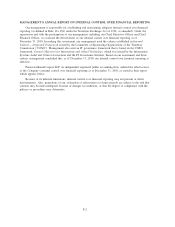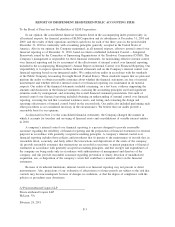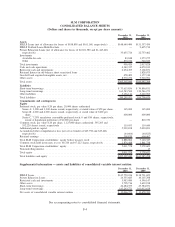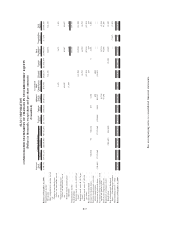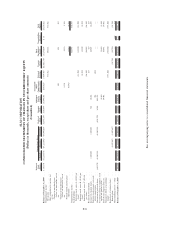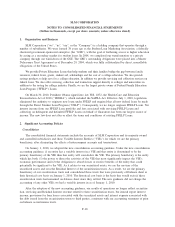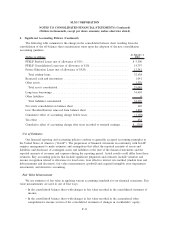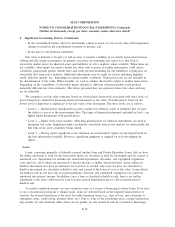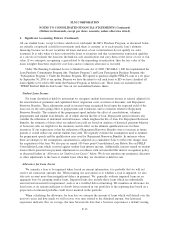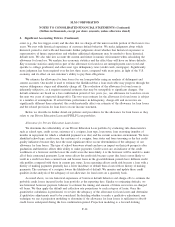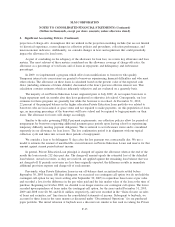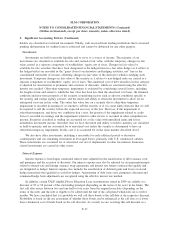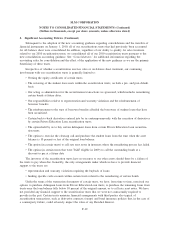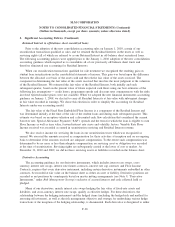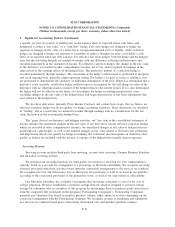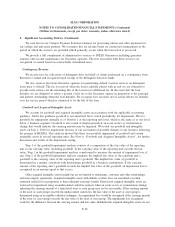Sallie Mae 2010 Annual Report Download - page 115
Download and view the complete annual report
Please find page 115 of the 2010 Sallie Mae annual report below. You can navigate through the pages in the report by either clicking on the pages listed below, or by using the keyword search tool below to find specific information within the annual report.2. Significant Accounting Policies (Continued)
• In the consolidated balance sheet for instruments carried at lower of cost or fair value with impairment
charges recorded in the consolidated statement of income; and
• In the notes to the financial statements.
Fair value is defined as the price to sell an asset or transfer a liability in an orderly transaction between
willing and able market participants. In general, our policy in estimating fair values is to first look at
observable market prices for identical assets and liabilities in active markets, where available. When these are
not available, other inputs are used to model fair value such as prices of similar instruments, yield curves,
volatilities, prepayment speeds, default rates and credit spreads (including for our liabilities), relying first on
observable data from active markets. Additional adjustments may be made for factors including liquidity,
credit, bid/offer spreads, etc., depending on current market conditions. Transaction costs are not included in
the determination of fair value. When possible, we seek to validate the model’s output to market transactions.
Depending on the availability of observable inputs and prices, different valuation models could produce
materially different fair value estimates. The values presented may not represent future fair values and may
not be realizable.
We categorize our fair value estimates based on a hierarchical framework associated with three levels of
price transparency utilized in measuring financial instruments at fair value. Classification is based on the
lowest level of input that is significant to the fair value of the instrument. The three levels are as follows:
• Level 1 — Quoted prices (unadjusted) in active markets for identical assets or liabilities that we have
the ability to access at the measurement date. The types of financial instruments included in level 1 are
highly liquid instruments with quoted prices.
• Level 2 — Inputs from active markets, other than quoted prices for identical instruments, are used to
determine fair value. Significant inputs are directly observable from active markets for substantially the
full term of the asset or liability being valued.
• Level 3 — Pricing inputs significant to the valuation are unobservable. Inputs are developed based on
the best information available. However, significant judgment is required by us in developing the
inputs.
Loans
Loans, consisting primarily of federally insured student loans and Private Education Loans, that we have
the ability and intent to hold for the foreseeable future are classified as held for investment and are carried at
amortized cost. Amortized cost includes the unamortized premiums, discounts, and capitalized origination
costs and fees, all of which are amortized to interest income as further discussed below. Loans which are
held-for-investment also have an allowance for loan loss as needed. Any loans we have not classified as
held-for-investment are classified as held for sale, and carried at the lower of cost or fair value. Loans which
are held-for-sale do not have the associated premium, discount, and capitalized origination costs and fees
amortized into interest income. In addition, once a loan is classified as held-for-sale, there is no further
adjustment to the loan’s allowance for loan loss that existed immediately prior to the reclassification to
held-for-sale.
As market conditions permit, we may securitize loans as a source of financing for those loans. If we elect
to use a securitization program to finance loans, loans are selected based on the required characteristics to
structure the desired transaction at the most favorable financing terms (e.g., type of loan, mix of interim vs.
repayment status, credit rating, maturity dates, etc.). Due to some of the structuring terms, certain transactions
may qualify for sale treatment while others do not qualify for sale treatment and are recorded as financings.
F-12
SLM CORPORATION
NOTES TO CONSOLIDATED FINANCIAL STATEMENTS (Continued)
(Dollars in thousands, except per share amounts, unless otherwise stated)


